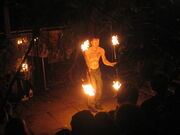Fire nunchaku (also known as firechux) refers to the use of a fuel to light part of the nunchaku (usually the tail) on fire for visual spectacles. The act of using fire nunchaku is sometimes referred to as firespinning.
Fire nunchaku is associated with other fire arts such as fire poi and fire staff.

A firespinner performing with fire nunchaku
Fuels[]
Main article: Fuels
There are two main types of fuels - hot fuels & cold fuels. The nomenclature refers to both the the temperature and to the flash point and hydrocarbon length of the fuel. Hot fuels are dangerous but more visually impressive while cold fuels are safer but less visually impressive. Hot and cold fuels are sometimes mixed to distribute the various advantages and disadvantages of each.
Clothes[]
The basic thumb rule for clothes is if you never wear anything synthetic (with the obvious exception to Kevlar) your clothes should be fine.
Jeans[]
Many people like to go for jeans on your bottom half. This is probably one of your best options if you are not willing to invest a lot of (unnecessary) cash. The fibres in jeans is woven together very tightly, which will ultimately make it less likely to catch on fire. However, something you should watch out for with jeans are the frayed edges. Often, I've seen people get the tear on their knees on fire. If this does happen to you, STOP. DROP. ROLL (see down for more info).
Cotton T-Shirts[]
If you have bought a decent t-shirt it should be cotton, but it's good to check the label anyway. Cotton T-Shirts are a very good option for your upper half. They are woven fairly tight, and are fairly tricky to light on fire. If you have a transfer (picture) on your shirt they can be made of other materials, and if they feel sort of like plastic they are. It's best to avoid T-Shirts with this on.
Leather[]
Leather is a good option as it is very fire retardant, and almost impossible to burn. But frankly, when you're firespinning you want to have the full movement of your body, and so I tend to avoid it. If, however, you don't mind this leather is a good choice!
Polyester/Nylon/Acrylic[]
These are all made (like paraffin) from crude oil. And so naturally they aren't exactly good to wear. Do not wear any of these. Some of them burst into flames, and other doesn't. There are way too many types of these man-made fibres to list here, but all of them will either light immediately, or start to melt. And when I say melt, I don't mean like hot wax. These clothes will shrink onto you, liquify then melt it's way into your skin if caught on fire. It's a truly terrible thing. DO NOT WEAR ANY OF THESE MATERIALS.
Ignite Times[]
Here is a short list of clothes and the times they take to light on fire when held in the flame from a lighter.
- Rayon 3.0sec
- Cotton 4.8sec
- Denim 5.0sec
- Silk 7.6sec
- 50/50 Cotton/polyester 9.2sec
- Polyester 10sec (takes 10 seconds to actually light on fire, but it shrinks into you instantly once put in a flame, and will cause severe skin injuries and burns.)
- Wool 10sec
- Leather 20+sec
Baggy/Wolly Stuff[]
Most over-baggy clothes are a bad idea. This is mainly because the flow of oxygen around the item of clothing is much greater making the clothes easier to light. Hoodies, for this reason, are usually a bad idea (unless you wear the hood up). Wolly/fluffy clothes catch on fire easily too due to the same method as above.